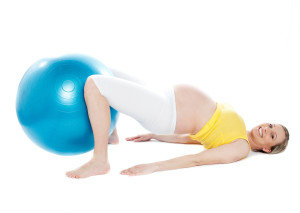Pregnancy brings incredible changes to your body—beyond the baby growing inside of you. To support your changing body, develop and maintain enough core physical strength to carry the extra weight up front. A strong core helps both you and your baby through the intense moments of labor and delivery. And after the birth, this core strength will allow you to move quickly through the postpartum recovery process.
Strong core = fewer backaches
Baby weight can be, well, a real pain. Most women gain 25 to 35 pounds during pregnancy—and it’s all distributed around the belly, which causes your center of gravity to tilt forward. To compensate, many women begin unconsciously over-arching the lower back, and rounding the upper back, which can lead to backaches and posture problems.
In addition, the aptly-named hormone relaxin has begun “relaxing” your ligaments to help your pelvis expand and make room for your baby. However, the effects of relaxin aren’t limited to your pelvis—you may also feel your spine loosening up, which forces your back muscles to work much harder to support you.
 Developing and maintaining strong core muscles will keep you more comfortable during your pregnancy by allowing you to carry your baby with greater ease. Your core supports your back, allowing you to maintain a correct posture and avoid the arching, rounding and straining that can cause persistent pain.
Developing and maintaining strong core muscles will keep you more comfortable during your pregnancy by allowing you to carry your baby with greater ease. Your core supports your back, allowing you to maintain a correct posture and avoid the arching, rounding and straining that can cause persistent pain.
Strong core = stronger delivery and recovery
Strengthening your abs, core and pelvic floor will also help with pushing during labor. If your abs are weak, you can’t push effectively. During the pushing phase of labor, you want to be able to draw in the deep transversus abdominis, or transverse muscle—your innermost abdominal muscle—and relax the pelvic floor to let your baby out. This transverse muscle wraps around your trunk like a corset and involuntarily contracts when you laugh, cough or sneeze. Because this motion compresses the abdominal cavity, it can help you push during labor.
And your pelvic floor? It’s a broad sling of muscles, ligaments and hammock-tissues that stretch from your pubic bone at the front of your body back towards the base of your spine. It supports your bladder, bowel and uterus, and gives you control over when you empty your bladder or bowels.
Pelvic floor exercises will:
- Help your vagina and perineum to heal more quickly
- Prevent and treat accidental bladder leakage
- Improve the circulation of blood to your perineum, which will help to reduce swelling and bruising post-birth
You can strengthen your pelvic floor muscles with Kegel exercises:
- Squeeze the muscles around the vagina as if you are stopping the flow of urine
- Hold for 10 seconds, breathing normally,
- Slowly release
- If you feel your upper abs contracting, you’re working too hard!
Do 20 reps five times a day. A strong core and pelvic floor will also help you recover more quickly from childbirth, and decrease pelvic floor issues after the birth.
How do I strengthen my core?
First, it’s important to know that you should consult with your doctor before attempting any new exercise during pregnancy. Your doctor knows any outstanding physical factors you may need to consider, and will also have a good idea of the kind of exercise you’ve been doing previous to your pregnancy.
In addition to consulting with your doctor, the type of exercises you can perform to help boost your core strength during pregnancy depends upon the trimester you are currently in. Know that throughout your entire pregnancy, low-impact, full-body exercises like swimming will always be a healthy choice, and that you should still aim to get 30 minutes of exercise a day, focus on core stabilization exercises. Prenatal yoga classes are great for this sort of training. Also, planks are a great way you can strengthen your core.
Once into the second trimester you can also begin to focus on movements that help stabilize your pelvis and hips, like resistance band walking and standing cable hip extensions.
Second and third trimesters: At this point, Kegel exercises and pelvic tilts are very important exercises. The kegels will build your control as the pressure on your bladder increases, and the pelvic tilts are great for strengthening you lower back muscles as well as releasing the stress on your lower back.
Beginning in the second trimester, you need to remember not to lie completely flat on your stomach (as if you could!) or your back, as doing so can cause an unsafe drop in your blood pressure. Twisting exercises such as seated abdominal twists are also off the table.
Here are some core exercises for you to try:
- You can do planks any number of ways safely during pregnancy. A few new ways to try include:
- Side planks
- Forearm planks
- Plank with opposite limb extension (right arm with left leg, left arm with right leg)
- Plank with elbow lift
- Seesaw Abs. Sit on the floor with your legs bent 90 degrees and your feet on the floor, place your hands behind your thighs for support. Gently lean back to activate your abdominal muscles. Use your obliques and lower abs to gently pull your belly button in. Hold back for five counts: do this five times. For advanced: Instead of using your arms for support, extend your arms straight out to your sides.
- Anything on a stability ball. The stability ball (what your doctor or doula may call a “birthing ball”) can be a pregnant woman’s best friend. You can safely strengthen your core muscles during pregnancy by incorporating a stability ball with other exercises.
- Sitting on the stability ball while performing other exercises engages the core muscles. For example, you can perform exercises with light free weights, like overhead press or bicep curls, while sitting on the ball.
- Pelvic tilts performed either on the ball, standing against a wall or on all fours will help strengthen the lower back and relieve some pain associated with pregnancy. Pelvic tilts can be performed lying on your back only prior to 20 weeks gestation.
- Another advantage of using the stability ball with exercises, especially later in pregnancy, is that it eliminates hard external pressure of a chair or other surface.
If core strength work is new to you, just take it slowly. Remember that the goal is to feel good and to feel healthy. Sometimes simply taking a daily walk or going for a swim can do just that. All prenatal exercise will help you combat the fatigue of pregnancy and keep you strong for the next amazing phase of your life—motherhood!

